Review of Trapezond 92 tobacco and features of its cultivation
The number of those who try to grow tobacco in their beds, increasing every year. First of all, this is due to the fact that you cannot find better quality products than those grown in your own garden. However, summer residents have a question, which variety to use for self-breeding?
We would like to draw your attention to Trapezond 92 tobacco. The outstanding smoking properties of this variety make the variety popular with connoisseurs. The plant is a high-yielding plant and does not require special attention.
The content of the article
What kind of tobacco is this
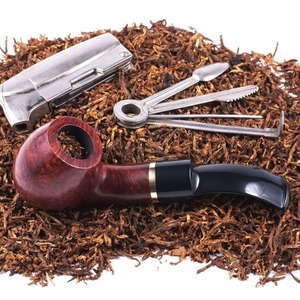
Tobacco Trapezond 92 (Trapezond) has become widespread not only in the southern regions, but also in the middle lane. This indicates its hardiness and good adaptation to unfavorable climates.
The main plus varieties - high quality of finished products.
Origin story
The place of origin of the variety is the Black Sea coast of the Caucasus. Immediately after its appearance, it became widely known in Turkey. An unpretentious and productive culture, Trapezond has taken root in many countries with different climates.
reference... The name of the variety comes from the Turkish city of Trebizond. Its current name is Trabzon.
Tobacco is universal in use: finished products are used not only for smoking, but also for cooking. Tobacco tends not only to increase the shelf life of homemade canned food, but also to add richness to the taste.
In medicine, it is used as an anti-inflammatory and disinfectant.
Features, characteristics, description
The plant is medium-sized, erect, with a medium-thick stem. The leaves are large, oval, light green in color with a pronounced central vein. Inflorescences are pale pink. Each seedling forms 20 to 30 leaves.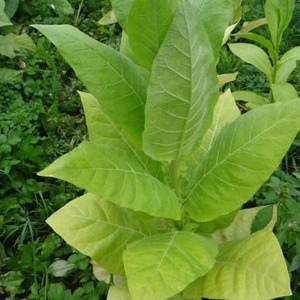
The variety is resistant to diseases such as root rot, tobacco mosaic and peronosporosis.
The ripening period is early, from the moment of sowing to harvesting, 85-90 days pass. The nicotine content is low - no more than 1%.
The yield is high - from 1 sq. m collect 3.5-3.8 kg. Recommended for cigars and pipes.
Dried tobacco leaves acquire a reddish tint and are famous for their high strength and low aromatization. Taste properties are rated at a high level.
reference! Smoking tobacco Trapezond refers to skeletal, that is, it is used as a basic raw material.
To improve the properties of tobacco use shadow drying and fermentation.
Where to buy and how much do seeds cost?
Trapezond tobacco can be purchased commercially in any specialty store. The seeds are also sold in online stores. The price of seed material is acceptable and does not exceed 70 rubles per package. The final cost of seeds depends on the manufacturer, the best price is offered by the agricultural firm "Gavrish" - 25-35 rubles.
Growing features
Planting seeds directly into the ground is possible only in the southern regions. In other cases, the culture is grown through seedlings. This is the only way the plant has time to mature and gain the declared varietal indicators.
Requirements for growing conditions
All tobacco plants are thermophilic, so an open area with a lot of light is chosen for them.Many plant bushes along the fence without giving them a separate bed in the garden.
Preparing seed, soil and planting containers
Preparation begins three days before sowing. Seed material is sown for seedlings in February.
Before this, the seeds are disinfected and germinated. To begin with, they are placed in a solution of tartaric acid for a day. A solution is prepared from 3 ml of tartaric acid and 100 ml of water. After a day, the seeds are spread on a paper towel to dry. Then they are laid out on the bottom of ceramic dishes with a layer not higher than 3 cm and moistened. The room temperature during germination should not exceed 28 ℃. After two days, the swollen seeds can be sown in the ground.
 The soil is prepared independently from garden soil, well mixed with river sand, peat and rotted manure in a ratio of 3: 1: 1: 1. The finished mixture is disinfected with a solution of pink potassium permanganate. After disinfection, the soil is laid out in planting containers.
The soil is prepared independently from garden soil, well mixed with river sand, peat and rotted manure in a ratio of 3: 1: 1: 1. The finished mixture is disinfected with a solution of pink potassium permanganate. After disinfection, the soil is laid out in planting containers.
Of the containers, disposable plastic cups are most often used, which are pre-treated with potassium permanganate. At the bottom of each cup, small drainage holes are made to drain excess moisture.
Before planting, the soil is moistened with warm, settled water. The seeds are buried 3-5 mm and sprinkled with earth on top. The containers are left in a bright room at room temperature.
reference... The disinfected seed material does not infect fungal diseases.
Seedling care
Seedling care consists in daily watering and maintaining the temperature at 20 ℃.
Water from a shallow watering can, without flooding the sprouts, so as not to provoke the occurrence of fungal infections. After watering, the soil is loosened to improve air exchange.
As soon as four real leaves are formed on the bushes, the first feeding is applied. 10 g of potassium salt, 30 g of superphosphate and 15 g of ammonium nitrate are dissolved in 5 l of water. Such feeding will accelerate the growth of seedlings.
Transplanted into the ground 50-60 days after sowing the seeds. A week before the transplant, hardening is carried out. Seedlings are taken outside in the daytime for several hours, thereby strengthening the immunity of young plants.
Transfer to soil
Seedlings are planted in the ground warmed up to + 10 ... + 12 ℃. Before planting, the soil is dug up and rotted compost with wood ash is introduced. A week later, the soil is dug up again and spilled with a solution of "Fitosporin" (5:10) for disinfection.
Planting pattern: 20 cm - distance between seedlings, 70 cm - between rows. After planting, the holes are watered abundantly with warm water.
Further tobacco care
Further care of the tobacco plant comes down to standard procedures: watering, fertilizing, weeding and loosening.
Watering
For the entire season, the plant is watered no more than three times, but abundantly. At least 8 liters of water are consumed for each seedling. Before watering, remove all inflorescences and stepsons.
Loosening and weeding is carried out after watering on wet soil. Removing weeds has a beneficial effect on the development of seedlings, and loosening improves oxygen access to the roots.
Top dressing
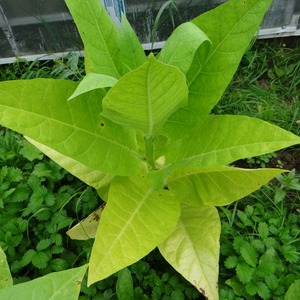
Immediately after transplanting, the seedlings are fed with superphosphate.
The next top dressing is foliar, it is carried out as soon as the inflorescences appear. The inflorescences are removed, and the leaves are sprayed with onion husk infusion. To prepare the infusion, you will need 0.5 kg of onion peels and 5 liters of water - they are cooked over low heat for 20-25 minutes. Then let it brew for a day and dilute with water in a ratio of 1: 0.5. This fertilizer is applied 2-3 times per season with an interval of 10-15 days.
reference! The infusion of onion husks saturates the plant with vitamins and protects against fungal infections.
Disease and pest control
With improper care of the plant, it is possible to be affected by fungal diseases, for example, powdery mildew. The seedlings are covered with a white bloom and wither soon. The disease is dangerously fast spreading from one plant to another.
The affected parts of the seedlings are removed, and healthy bushes are sprinkled with wood ash.During illness, watering is stopped, as fungal infections love moisture. Wet beds are covered with sand, otherwise the fungus will continue to grow.
reference! Tobacco belongs to the plants of the nightshade family. The same diseases and pests are dangerous for him as for potatoes, tomatoes, peppers and eggplant.
Of the pests, seedlings attack: aphids, thrips and slugs. With a large accumulation of insects, the drug "Aktara" is used, but if there are few pests, it is quite possible to do with folk remedies. Soaping the plants will protect them from aphids and slugs. The solution is prepared from a piece of laundry soap dissolved in a bucket of warm water. You can also spray the soil with a 1% solution of Bordeaux liquid.
Harvesting
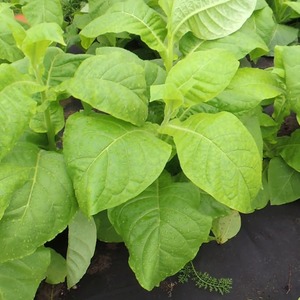
The leaves are pruned when they brighten and stop growing. The crop is harvested with scissors, carefully, without damaging other leaf plates.
The collection is carried out starting from the lower leaves. If the upper leaves remain the same color, you should not cut them off. They will reach full maturity in 2-3 days.
After harvest proceed to further processing of raw materials.
Further processing
Harvested tobacco leaves are not ready for consumption. To turn raw materials into finished products, they carry out drying and fermentation.
Drying
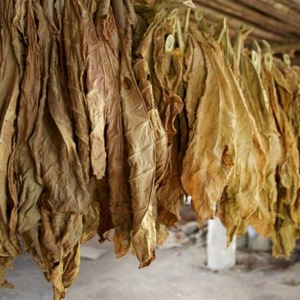
The foliage is laid out on the floor on a piece of fabric. In this form, it is kept for a day, then one sheet is placed on top of another, creating beams no thicker than 2 cm, and left for three days. During these three days, one sheet at a time is pulled out from the middle of the bundles and laid on the side. So greens are etched from the leaves - they carry out cheering. Green leaves cannot be fermented.
The baked leaves are strung on a string and hung in a room with a temperature of 25 ℃ and a humidity of no more than 60%. As soon as the central vein is dry, it is removed from all the leaves, and the leaves themselves are cut and placed on the battery. Further drying takes a month. Raw materials are periodically inspected, not allowing it to dry out.
It is interesting! Until the beginning of the 18th century, tobacco smoking was called "dry drunkenness" in Russia.
Fermentation
Fermentation is carried out using vodka and honey. Half a teaspoon of honey is dissolved in 1.5 tablespoons of vodka. The dried tobacco leaves are placed in a 200 ml glass jar and filled with the finished mixture.
After thorough mixing, the jar is placed in a pot of water and put on fire. As soon as the water heats up, the can is opened and steam is released from it. After that, the jar is again closed with a lid and kept on fire for at least two hours. Then they put a hot jar on the battery, where it warms up for another two weeks.
At the end of the procedure, the tobacco is ready for use.
Advantages and disadvantages of the variety
The culture has become popular around the world for its many benefits:
- ease of care;
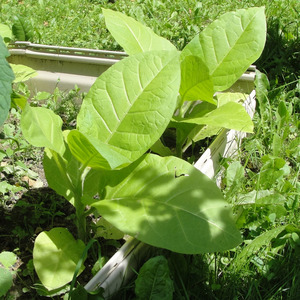
- the possibility of breeding in all regions;
- high productivity;
- disease resistance;
- strength and moderate sweetness.
The only drawback is the need to exfoliate the foliage before fermentation.
Reviews of tobacco growers
The culture is known to most tobacco gardeners. Almost all the reviews are positive - farmers appreciate both the smoking and agricultural qualities of the variety.
Andrey, Tula: «I have been breeding tobacco for over 10 years. I plant different varieties, including Trapezond. Compared to others, this plant adapts faster to weather changes and gives a good harvest. I didn't notice any difficulties in caring for him. The plant is unpretentious and practically does not get sick. "
Stepan, Kursk: “I grow this variety only because of its rich and unique taste. It is moderately strong, moderately sweet, without any pronounced aroma. In short, a real male smoking blend. I use it not only for stuffing pipes, but also as a seasoning for meat and side dishes. "
Conclusion
Tobacco Trapezond 92 is not only a high-yielding culture, but also of high quality.The smoking blend is strong and moderately sweet. The nicotine content in tobacco does not exceed 1%, which makes it possible to use it as a seasoning for various dishes.